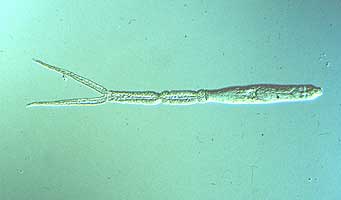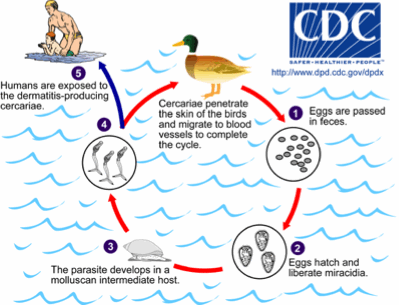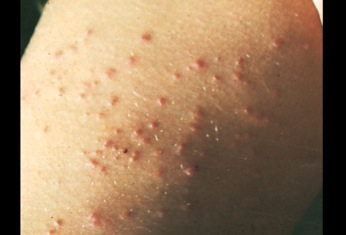Cercarial dermatitis
Contributor: David Marcogliese
Biology: Cercarial stages of schistosome trematodes normally infect waterfowl such as ducks, geese and swans, and mammals such as muskrat and beaver. Schistosomes known to cause cercarial dermatitis in North America include species of Australobilharzia, Gigantobilharzia, Schistosomatidium and Trichobilharzia.

Figure 1. Cercariae of Austrobilharzia variglandis, which can cause cercarial dermatitis (Source: DPDx).
Life cycle: Adult parasites occur in waterfowl and aquatic mammals. Eggs shed with faeces hatch in water, releasing miracidia. The miracidium penetrates a snail, develops into a mother sporocyst, then producing daughter sporocysts. These daughter spororcysts asexually produce cercariae, which are released into the water and may infect birds. In Canada, such snail hosts include Lynmaea catascopium, Stagnicola emarginata, Stagnicola elodes, Stagnicola palustris, Physella gyrina and Physa spp.

Figure 2. Life cycle of avian schistosomes, which are the causative agent of cercarial dermatitis (Source: CDC).
Transmission: Humans are accidental hosts. Cercariae infective to birds or mammals attempt to penetrate humans, but typically die soon after contact. The disease is associated with recreational water use.
Prevalence: Worldwide; every continent except Antarctica. Considered a “rare disease” in the United States by the Office of Rare Diseases (National Institutes of Health). Within Quebec, in 1988 a total of 74 reported cases traced to 28 water bodies in five regions. Globally, reports are increasing in frequency, possibly due to climatic changes or improved awareness.
Susceptible populations: recreational water users, especially bathers.
Symptoms: Mild, non-specific inflammatory skin responses, a tingling sensation, red spots and itching, give rise to the term “swimmer’s itch”. Immune hypersensitivity can occur upon re-exposure. Symptoms develop in 30-40% of those exposed for the first time and normally persist for about a week. Scratching can lead to secondary infections.

Figure 3. Skin of patient showing the inflammatory response to cercariae in the skin (Source: DPDx).
Treatment: Avoid scratching; apply Calamine lotion; corticosteroid cream; baking soda paste; cool compresses; soda, Epson salts or colloidal oatmeal baths; and take antihistamines.
Control Measures: Prophylactic measures include treating waterfowl near swimming areas with Prazinquantel; driving birds away; using molluscicides (e.g., copper sulfate) near beaches; or mechanical removal or disturbance of snails; biological control of snails or parasites; topical application of DEET, other insect repellants, water repellants, or fragrant suntan oils; towelling down vigorously after water contact; showering after leaving the water; avoiding vegetated areas; and posting public advisories; all with varying levels of success.